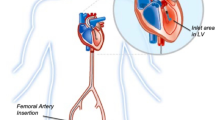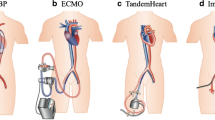Abstract
Purpose of Review
The available platforms for temporary circulatory support (TCS) have expanded to include impeller technologies in addition to the traditional approaches with centrifugal pumps and intra-aortic counterpulsation. We review the evidence for competing technologies, relative risk, and benefit of individual TCS platforms and provide a consensus opinion in the context of our institutional experience.
Recent Findings
Trans-aortic axial flow devices (Impella) have significantly impacted the support of patients with cardiogenic shock. Despite the absence of prospective randomized data, the use of both percutaneous and surgical Impella devices is ubiquitous among heart failure centers and rapidly evolving. Extracorporeal centrifugal pumps remain the technology of last resort.
Summary
Despite the increasing use of new TCS platforms, there is little empirical evidence that outcomes have been impacted. Increasingly, systems of care—rather than technology—are seen as the more important variable in the management of patients with cardiogenic shock.
Access this article
We’re sorry, something doesn't seem to be working properly.
Please try refreshing the page. If that doesn't work, please contact support so we can address the problem.

Similar content being viewed by others
References
Papers of particular interest, published recently, have been highlighted as: • Of importance •• Of major importance
Impella Ventricular Systems. Instructions for use and clinical reference manual. United States. Document No. 0042-9028rG. 2020.
Impella 5.5 with smartassist for use during cardiogenic shock. Instructions for use and clinical reference manual. United States. Document No. 0550–9002 rA. 2019.
Ramzy D, Soltesz E, Anderson M. New circulatory support system outcomes. ASAIO J, in press. 2020;66:746–52.
Succar L, Sulaica EM, Donahue KR, Wanat MA. Management of anticoagulation with Impella® percutaneous ventricular assist devices and review of new literature. J Thromb Thrombolysis. 2019;48(2):284–91.
Amin AP, Spertus JA, Curtis JP, Desai N, Masoudi FA, Bach RG, et al. The evolving landscape of Impella use in the United States among patients undergoing percutaneous coronary intervention with mechanical circulatory support. Circulation. 2020;141:273–84. https://doi.org/10.1161/circulationaha.119.044007.
O'Neill WW, Grines C, Schreiber T, Moses J, Maini B, Dixon SR, et al. Analysis of outcomes for 15,259 US patients with acute myocardial infarction cardiogenic shock (AMICS) supported with the Impella device. Am Heart J. 2018;202:33–8.
Vetrovec GW, Anderson M, Schreiber T, Popma J, Lombardi W, Maini B, et al. The cVAD registry for percutaneous temporary hemodynamic support: a prospective registry of Impella mechanical circulatory support use in high-risk PCI, cardiogenic shock, and decompensated heart failure. Am Heart J. 2018;199:115–21.
Basir MB, Kapur NK, Patel K, Salam MA, Schreiber T, Kaki A, et al. Improved outcomes associated with the use of shock protocols: Updates from the national cardiogenic shock initiative. Catheter Cardiovasc Interv. 2019;93(7):1173–83. https://doi.org/10.1002/ccd.28307.
Bonello L, Delmas C, Gaubert M, Schurtz, Ouattara A, Roubille F. Trials of mechanical circulatory support with percutaneous axial flow pumps in cardiogenic shock complicating acute myocardial infarction: mission impossible? Arch Cardiovasc Dis. 2020. https://doi.org/10.1016/j.acvd.2020.02.001.
Udesen NJ, Moller JE, Lindholm MG, Eiskjer H, Schafer A, Werner N, et al. Rationale and design of DanGer shock: Danish-German cardiogenic shock trial. Am Heart J. 2019;214:60–8. https://doi.org/10.1016/j.ahj.2019.04.019.
Cheng R, Tank R, Ramzy D, Azarbal B, Chung J, Esmailian F, et al. Clinical outcomes of Impella microxial devices used to salvage cardiogenic shock as a bridge to durable circulatory support or cardiac transplantation. ASAIO J. 2019;65:642–8.
Seese L, Hickey G, Keebler ME, Mathier MA, Sultan I, Gleason TG, et al. Direct bridging to cardiac transplantation with the surgically implanted Impella 5.0 device. Clin Transpl. 2020;34(3):e13818. https://doi.org/10.1111/ctr.13818.
den Uil CA, Akin S, Jewbali LS, dos Reis MD, Brugts JJ, Constantinescu AA, et al. Short-term mechanical circulatory support as a bridge to durable left ventricular assist device implantation in refractory cardiogenic shock: a systematic review and meta-analysis. Eur J Cardiothorac Surg. 2017;52:14–25.
•• Hernandez-Montfort JA, Xie R, Ton VK, Meyns B, Nakatani T, Yanase M, et al. Longitudinal impact of temporary mechanical circulatory support on durable ventricular assist device outcomes: An IMACS registry propensity matched analysis. J Heart Lung Transplant. 2020;39(2):145–56. https://doi.org/10.1016/j.healun.2019.11.009An extensive discussion of the impact of TCS on subsequent durable LVAD outcome including propensity analysis comparing the hazard of different TCS technologies.
Rao P, Khalpey Z, Smith R, Burkhoff D, Kociol RD. Veno-arterial extracorporeal membrane oxygenation for cardiogenic shock and cardiac arrest. Circ Heart Fail. 2018;(9):e004905. https://doi.org/10.1161/CIRCHEARTFAILURE.118.004905.
• Raman J, Alimohamed M, Dobilovic N, Lateef O, Aziz S. A comparison of low and standard anti-coagulation regimens in extracorporeal membrane oxygenation. J Heart Lung Transplant. 2019;38(4):433–9 Anecdotal, but part of a growing literature challenging the role of systemic anticoagulation in patients supported with ECLS/ECMO.
Chung YS, Cho DY, Sohn DS, Lee WS, Won H, Lee DH, et al. Is stopping heparin safe in patients on extracorporeal membrane oxygenation treatment? ASAIO J. 2017;63(1):32–6. https://doi.org/10.1097/MAT.0000000000000442.
Russo JJ, Aleksova N, Pitcher I, Couture E, Parlow S, Faraz M, et al. Left ventricular unloading during extracorporeal membrane oxygenation in patients with cardiogenic shock. J Am Coll Cardiol. 2019;73:654–62.
• Meuwese CL, Koudstaal S, Braithwaite S, Hermens JAJ, Donker DW. Left ventricular unloading during extracorporeal membrane oxygenation: Insights from meta-analyzed observational data corrected for confounders. J Am Coll Cardiol. 2019;73(23):3034–5. https://doi.org/10.1016/j.jacc.2019.03.505An interesting discussion of the controversies over mechanical unloading.
• Esposito ML, Zhang Y, Qiao X, Reyelt L, Paruchuri V, Schnitzler GR, et al. Left ventricular unloading before reperfusion promotes functional recovery after acute myocardial infarction. J Am Coll Cardiol. 2018;72:501–14. https://doi.org/10.1016/j.jacc.2018.05.034An important basic science study demonstrating the impact of mechanical unloading on initiating a molecular cardio-protective program for subsequent myocardial recovery (enhanced SDF-1a activity).
Vallabhajosyula S, O'Horo JC, Antharam P, et al. Venoarterial extracorporeal membrane oxygenation with concomitant Impella versus venoarterial extracorporeal membrane oxygenation for cardiogenic shock. ASAIO J. 2020;66(5):497–503. https://doi.org/10.1097/MAT.0000000000001039.
• Donker DW, Brodie D, JPS H, Broomé M. Left ventricular unloading during veno-arterial ECMO: A simulation study. ASAIO J. 2019;65(1):11–20. https://doi.org/10.1097/MAT.0000000000000755A direct mechanical comparison of the available platforms available to unload the left ventricle.
Vallabhajosyula S, O’Horo JC, Antharam P, Ananthaneni S, Vallabhajosyula S, Stulak JM, et al. Concomitant intra-aortic balloon pump use in cardiogenic shock requiring veno-arterial extracorporeal membrane oxygenation: a systematic review and meta-analysis. Circ Cardiovasc Interv. 2018;9. https://doi.org/10.1161/CIRCINTERVENTIONS.118.006930.
Bréchot N, Demondion P, Santi F, et al. Intra-aortic balloon pump protects against hydrostatic pulmonary oedema during peripheral venoarterial-extracorporeal membrane oxygenation. Eur Heart J Acute Cardiovasc Care. 2018;7:62–9.
Kirklin JK, Pagani FD, Goldstein DJ, John R, Rogers JG. American Association for Thoracic Surgery/ International Society for Heart and Lung Transplantation guidelines on selected topics in mechanical circulatory support. J Heart Lung Transplant. 2020;39(3):187–219.
Siriwardena M, Dozois M, Fan E, Billia F. Hemodynamic aspects of veno-arterial extracorporeal membrane oxygenation for cardiac support: a worldwide survey. ASAIO J. 2020;66(5):489–96. https://doi.org/10.1097/MAT.0000000000001024.
Author information
Authors and Affiliations
Corresponding author
Ethics declarations
Conflict of Interest
The authors declare that they have no conflicts of interest.
Human and Animal Rights and Informed Consent
This article does not contain any studies with human or animal subjects performed by any of the authors.
Additional information
Publisher’s Note
Springer Nature remains neutral with regard to jurisdictional claims in published maps and institutional affiliations.
Topical Collection on Cardiogenic Shock: Progress in Mechanical Circulatory Support
Rights and permissions
About this article
Cite this article
Gongora, E., Orozco, E. & Hoopes, C. Temporary Circulatory Support With Ventricular Assist Devices: Update on Surgical and Percutaneous Strategies. Curr Heart Fail Rep 17, 350–356 (2020). https://doi.org/10.1007/s11897-020-00491-x
Accepted:
Published:
Issue Date:
DOI: https://doi.org/10.1007/s11897-020-00491-x




